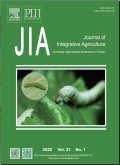农业科学学报(英文)2024,Vol.23Issue(11):3860-3869,10.DOI:10.1016/j.jia.2023.10.028
Genetic and biological properties of H10Nx influenza viruses in China
Genetic and biological properties of H10Nx influenza viruses in China
摘要
关键词
avian influenza virus/H10 subtype/adaptation/pathogenicityKey words
avian influenza virus/H10 subtype/adaptation/pathogenicity引用本文复制引用
Yina Xu,Daxin Wang,Ying Zhang,Hailing Li,Haoyu Leng,Chaofan Su,Siqi Tang,Yongtao Wang,Shiwei Zhang,Yali Feng,Yanan Wu..Genetic and biological properties of H10Nx influenza viruses in China[J].农业科学学报(英文),2024,23(11):3860-3869,10.基金项目
This research was supported by the National Key Research and Development Program of China(2021YFD1800200),the National Natural Science Foundation of China(32170539,32000357)and Liaoning Revitalization Talents Program,China(XLYC2007114). (2021YFD1800200)

